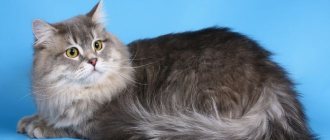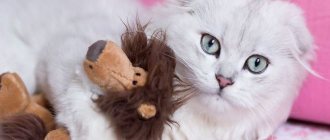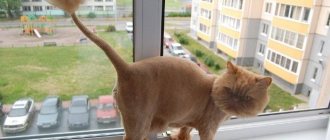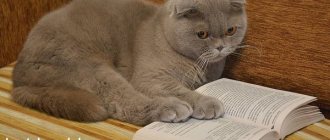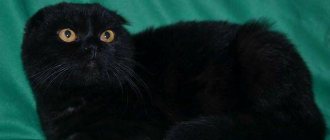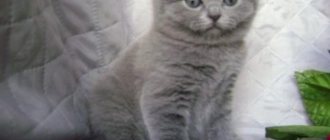The Scottish longhaired straight-eared cat Highland Straight (translation from English from the word “highland”) is a type of Scottish cat breed, the features of which are erect ears and long hair. The advantages of the fluffy Scottish straight-eared cat breed are the same as those of other Scots: good character, calm disposition, sweet appearance, fairly simple maintenance. Highland straights are absolutely stunning creatures, very beautiful, simply fabulous. Unfortunately, the popularity of these cats is still lower than they deserve.
Article continues after advertisement Highland Straight cats: photos
History of the breed
The Highland Straight breed gained recognition only at the end of the last century, although there are plenty of people who want to have a straight-eared Scottish. These cute creatures are a constant success at cat shows.
Highland Straight
The ancestors of modern individuals were wild cats living in the mountains of Scotland. Crossing them with a Persian cat, then with a British one, made it possible to obtain enormous diversity within the breed.
Other and obsolete names of the breed
The breed includes varieties with hanging ears - Scottish Folds, Highland Folds and with erect ears - Scottish Straights and Highland Straights. They differ:
- the structure of the ears;
- coloring;
- length of wool.
Differences between Scottish cats and British cats
It is the straight-eared Scots who are easily confused with the British. These breeds are really similar. Dense muscular body and rounded shape, plush fur. But if you put two animals side by side, the difference will become noticeable.
This learned cat will try to explain the difference between British and Scottish cats
Differences between Scottish Straight cats and British ones:
- Ears.
Straights have ears that do not have a crease like folds. They are narrower at the base than the British and are not so widely spaced. The Scottish ears stand upright, without tilting forward or moving to the side. This is necessary to obtain a beautiful fold in lop-eared offspring.
Young Scottish Straight
- Head shape.
The main difference between the British is their prominent cheeks. Due to them, the cat's head is rather oval. The Scots have a small and round head.
Scottish cats have much more modest cheeks than British cats.
- Body type.
The British have short and thick paws, while the Scots have long ones. Due to their high paws, Straights do not look squat, they are lighter and slimmer.
Scottish Straight
- Tail.
Scottish cats have a long, thinner tail, while British cats have a short, thick “club” with a rounded tip.
Scottish Straight stretched out on the sofa
- Wool.
Straight-eared Scottish cats are divided into two categories based on coat type:
- Scottish Straights have a short, dense, smooth coat.
- Highland Straights are semi-longhaired cats, they have a luxurious collar and pants, and a tail that resembles a fan.
Highland Straight cats have incredibly thick fur.
British cats are more plush to the touch and can only be shorthaired.
All cats love boxes. Highland straight color point
All the differences between the British and the Scots can be visualized with this picture:
Differences between British and Scottish cats
Appearance
Like any other breed, the Highland Straight has its own standards. Compliance with them is especially important for exhibition specimens.
Highland Straight: description of the breed (WCF standard)
Highland fold (Scottish fold longhair cat)
The Scottish Longhair cat has a dense, rounded body. Due to the short paws, there is some stockiness.
The animal's head is large and round. Very beautiful large, round eyes, plump cheeks. The profile is soft, with a neat round chin. The cat's ears are small, pointed at the top and wide at the base. The tail is fluffy, mobile, and short.
The weight of males reaches 5 kg, and that of females - up to 3.5 kg. Cats are distinguished by the presence of a fluffy “collar”.
Interesting! The color of animals can be completely different. It is noteworthy that the color of the iris matches the color of the coat.
How much does it cost and where to buy a kitten?
Scottish longhair kittens are sold at a very reasonable price. For an ordinary representative you will have to pay 6-8 thousand rubles. Kittens with good pedigree are sold at prices ranging from 15 to 25 thousand.
Scottish catteries in Russia:
- Vesolyi Shmel St. Petersburg;
- BASTETFOLD Barnaul;
- ANYKEY Moscow;
- "Platinum Orel" Orel;
- "Kapael" Omsk;
- "Lapusik ru" St. Petersburg;
- Bella Valencia Krasnodar;
- Nemezida, Ufa;
- "Maneki Neko" Smolensk;
- PEARL'S SONG Moscow;
- Magic Diamond Rostov-on-Don.
There are quite a few nurseries in our country that breed Scottish Fold and Straight-eared kittens. In almost every city you can find a specialized establishment where you will always be offered a beautiful long-haired kitten at an affordable price.
Character and behavior
The Scottish Straight Longhair cat is an ideal pet for pets. There are no problems with potty training or scratching posts.
Scottish Straight (Scottish Straight cat)
Friendly and inquisitive animals can easily occupy themselves with independent play, but they immediately respond to the call of their owner. Although playfulness ends with growing up. Adults prefer a soft chair. They can lie around the clock, distracted only by feeding and taking care of natural needs.
Scots Longhairs have a very good memory. Insults do not go unanswered. By scolding and using force, you can forever lose trust on their part. They also cannot stand noise and screams - they try to move away and hide.
Relationship with the owner
The animal chooses one owner and treats the rest of the family with respect. It is very hard for him to part with his owner, but he soon switches to someone else.
The Scottish Straight and long-haired cat is very attached to its home. Any change of environment is stressful for her.
Interesting! Highlands come to their owner for affection only voluntarily. It is impossible to force them to lie on your lap or next to you in bed.
Relationship with other pets
There are no problems with other pets. If a cat starts hunting, it will be some kind of flying insect. Only nursing mother cats can show aggression.
Hereditary diseases of Scottish Straights
With proper feeding, Scottish Straight cats do not suffer from problems with the musculoskeletal system. They are deprived of the “loop ear gene,” which deforms not only the auricle, but also the rest of the cartilage in the body. But besides osteochondrodysplasia, there are a number of genetic diseases to which Scottish cats are susceptible.
Hypertrophic cardiomyopathy
A hereditary disease that affects Scottish, British cats, Maine Coons and other breeds. In sick animals, the walls of the heart gradually thicken, and its cavities become smaller. The blood pumping gets worse and worse, and eventually the young animal dies. Pulmonary edema can be triggered by anesthesia (for example, during castration surgery), stress, and physical activity.
All Scottish Straights are recommended to have a cardiac ECHO before general anesthesia or as planned upon reaching 1 year of age.
Young Scottish Straight
Polycystic kidney disease
The Scots were “rewarded” with this disease by the Persians, who were actively used in breeding the breed. Polycystic kidney disease is insidious in that it can be hidden for a long time. An animal with excellent appearance may win shows and produce several litters before succumbing to progressive kidney failure.
There are genetic tests that can reliably determine whether a cat is a carrier of polycystic disease. But no one can oblige breeders to do research before breeding. If the parents of your Scottish kitten have not passed such a test, you can examine the kitten you like at your own expense before purchasing.
Highland Straight Blue
If the Scottish Straight is free from hypertrophic cardiomyopathy and polycystic kidney disease from birth, then with good care it will live a long life.
Features of care
Scottish fold cat (Scottish fold)
Like all cats, Scottish Longhairs are extremely clean cats. They can lick their fur for hours. Given the long and thick hair, the owner should help the pet keep its coat in good condition.
Long-haired cats need special coat care
The same applies to keeping your cat's litter box clean. She will not go into a dirty one; she will rather find a suitable place for herself (but not for her owners!) outside the potty.
Additionally, you should clean your pet's eyes and ears.
Grooming
It is advisable to brush your cat daily. At the very least, you should run a wet palm over the skin. If you do this often enough, you can get by with weekly brushing.
Important! Under no circumstances should tangles be allowed to form.
Washing Highland Straight
Representatives of the breed, despite their long hair, do not need frequent washing. Usually three times a year is enough. For bathing, you need to use a special shampoo and rinse off very well after the procedure. The balm will help add volume and silkiness to the coat.
Important! It is absolutely forbidden to use human cleaning products.
If the animal is not very afraid, then you can dry the wool with a hairdryer.
Combing
You can use various combs to brush your cat. It could be:
- brush with rounded metal teeth;
- slicker;
- mitten with spiked teeth;
- furminator;
- comb;
- massage brush made of natural bristles.
Walk
Representatives of the breed are small lovers of walking. There is no need to force them outside. Walking on the balcony is quite enough for them. If you come across a traveler specimen, you will need to buy a harness at the store and take it with you to parks or green alleys.
Reviews from owners of Scottish Straight cats
“Although the Scots are often described as super-domestic cats, our Mason is a true hunter. In the apartment he manages to catch flies, and he grabs the toy the first time, without much teasing. Exceptional cat! He has his own opinion on everything. I love talking to him – he always mumbles something in response.”
“What I like most is that our Scottish Straight does not single out any one person from the family. She loves both me and her husband equally. And sits in both of their arms, and approaches everyone to ask for food. He tolerates loneliness well, which is also important - we both work a lot. We leave him a bunch of toys as compensation. It is not given to guests at all, although it has never scratched anyone. My husband is secretly pleased with this, he considers the cat a loyal and correct boy.”
“Our Busilda was transformed gradually. When they brought me this skinny worm on legs for my birthday, I didn’t believe that it was a purebred Scot. I got it, I think, on Avito, for three rubles. But a kitten is like a child, you will love anyone. At 5 months the coat began to bloom and change color. And by the age of one year, Busya had become a cheeky, plush, stately beauty! We castrated her early, at 6 months, but there is no excess weight, just nice roundness.”
“I adopted a Highland Straight after I couldn’t persuade my family to adopt a Persian cat. I have never regretted it! Simon is absolutely devoid of aggression, goes to the litter box without a single mistake, and always sleeps with me. He purrs a lot, my little babbler. I comb it twice a week to prevent tangles from forming. It’s not difficult, but the cat is amazingly beautiful! Grew up to 5 kg, large, but in moderation"
“Highland Straight became the second Scot in our family. Without hiding I say that the kitten was taken for children. Blue with yellow eyes, incredibly fluffy - tail like a fan, fur pants, collar. Very affectionate and patient, a full member of the family."
Feeding
Highland Straights are not picky eaters, but it is easiest to keep them on premium dry food. They are balanced, that is, they contain everything you need.
If natural nutrition is meant, then the menu should include:
- dietary meat (beef, rabbit, chicken, turkey);
- cereals (buckwheat, rice);
- kefir (ryazhenka, yogurt);
- greenery;
- vegetables;
- vitamin supplements.
Food from the table is strictly not recommended. The meat should be scalded with boiling water before serving. And under no circumstances should you give cow's milk.
Interesting! These pets never beg for food. They will wait patiently until the owner takes care of them.
Highland straight character
You can immediately identify the main characteristic features inherent in this breed and largely determining its behavior:
- absolute gentleness and extremely rare manifestations of aggression;
- enviable endurance and patience;
- attentiveness, high intelligence, ability to learn quickly.
The character of this breed is extremely good-natured and peaceful. They are able to adapt to the mood of the place in which they live and adopt its energy. develop some independence once they reach adulthood .
However, they still love to be close to their owner, although at the same time they know how to remain unobtrusive and respect human space - when the animal feels that you need to be alone, it will certainly provide such an opportunity. Another distinctive character trait of the Scottish Longhair cat is their incredible endurance and patience . Due to their peaceful nature, they are never in a hurry and are quite calmly ready to wait for a long time until the owner gets rid of his business and chooses time to feed or exercise with them.
What these cats do not forgive is a violent attitude towards themselves - any methods of education involving shouting or beating will be ignored, and in the future you can no longer count on a favorable attitude on the part of the animal. Moreover, there is a risk that the cat will also begin to take revenge after this, since, like all cats, Highland Straights can be very vindictive . Therefore, testing the strength of a cat’s nerves is highly not recommended.
Scots value attention , are inclined to communicate, are almost completely devoid of aggression and get along well with other pets. Often, they choose the animals with which they live together as play partners, and later become best friends with them.
The development of relationships between Highland Straights and children should be supervised by parents. Despite the fact that the animals are not aggressive, it would still be better to make sure that the child does not somehow accidentally offend the cat or cause it pain.
The Longhaired Scotsman has high intelligence , good memory and is highly trainable .
Health status
Scots are born in good health. No genetic abnormalities in development were found. If the maintenance rules are followed, Scottish representatives live 12-20 years.
The color of the eyes and fur of cats can be different.
Tendency to diseases
Due to their lack of mobility, Highlands easily gain excess weight and this can lead to problems with the spine and musculoskeletal system.
In order to maintain the health of your pet, it is imperative to vaccinate it, doing this annually. There are two mandatory types of vaccines.
Antiviral and anti-infective against such diseases:
- rhinotracheitis;
- panleukopenia;
- calicivirus;
- chlamydia;
- rabies.
If there are other pets living in the house, it would be a good idea to add vaccinations against:
- ringworm;
- coronavirus;
- viral leukemia;
- infectious peritonitis.
Important! Half a month before vaccination, the animal must be treated for worms.
The start of vaccinations depends on the kittens' lifestyle. If they are nursed by their mother, antibodies protect them through milk. Artificial or weaned kittens should begin to be vaccinated at 2.5 months of age.
Features of the Highland Fold breed
This is explained by the fact that Highlands love to be in the center of attention, in the company of their owner, they adore communication and receive it in abundance. And being in close proximity to a person, an intelligent animal easily learns the necessary norms of behavior, even without much effort on the part of the owner.
The Scottish Highland Fold simply exudes peacefulness. He is not at all interested in defending leadership positions or showing dominance. There is absolutely no aggression in this breed.
Such a cat is absolutely not scandalous, has a great attitude towards children, and playing with kids gives them real pleasure. If there is already a pet in the house, then the handsome Highland will quickly find a common language with him. This cat has its own attitude towards each of the family members.
Children are play partners, with the head of the family you can calmly lie on the sofa and watch TV, you can gently rub your back against the legs of the mistress of the house, and at the same time beg for a tasty morsel, and with the older generation you can simply take a nap or “help” with knitting. That is, such a pet is ideal for any family. Highland does not create problems in its maintenance. He will not yell in the absence of his owners; at this time he will prefer to sleep.
Moreover, he emits a soft, pleasant meow or purr only when he is addressed. All these qualities emphasize the nobility of nature and very dignified behavior.
We suggest you read: Capuchin at home
Breeding
The Highland Straight can be mated with any representatives of the Scots species. It can be:
- similar specimens (but not closely related);
- fold (fold) with short/long hair.
At one time, a mother cat can give birth to 5-6 cubs. What ears will be like will become clear by 1.5-2 months. The mating of a short-haired individual with a long-haired one implies the birth of babies with different hair lengths.
Mated cats can be used from 10 months, and cats from 1.5 years. The meeting of animals takes place on the territory of the seal and lasts 2-3 days.
We must remember! Before mating, both partners must undergo the necessary vaccinations and deworming.
A cat gives birth after about 65 days. The onset of labor can be understood by behavior. She begins to look for a secluded place - prepares a nest.
Pregnancy and childbirth in representatives of the breed usually occur without complications. Kittens are looked after by both parents (if any). They are very responsible and caring parents. They will teach you everything they know.
Scots colors
Plain (solid)
The coat color is uniform, without interspersing any other color. Any spots or stripes are considered a defect in a solid color.
- white;
- black (ebony);
- red (deep red);
- blue (blue) - kittens with such gray fur most resemble a British shorthair cat;
- chocolate (dark brown) – a rather rare color for Scots;
- lilac (lavender) – a cool shade of fur, without redness;
- cream – warm beige color, paws and nose match the shade of the coat;
- fawn (light beige) – the color of the fur of a young fawn; cats of this color have soft pink paw pads and nose;
- cinnamon is a warm, light shade of brown, the paw pads and nose are always pink.
Bicolors (two-color)
The main color is white, it makes up from 1/2 to 1/3 of the entire body. The second color is any of the solid ones. Cats with a symmetrical pattern and color distribution are valued higher.
The most popular bicolor colors among Scottish Straights are:
- Blue.
- Black.
- Chocolate.
- Cream.
Color point
Color point cats have a light body and dark face, ears and paws. The gene responsible for color is linked to blue eye color.
- Blue point - blue spots.
- Lilac point – lilac shades.
- Seal point is a Siamese with black markings.
- Choklit point - chocolate markings.
- Red point - red shades.
Tortoiseshells
Tortoiseshell color is usually red, black and white spots unevenly distributed on the main color of the coat, which, under the influence of the genes of the parents, can take on blue, cream, chocolate and red shades. Tortoiseshell colors are conventionally divided into 3 types:
- Calico is a patchwork color, spots of different colors are quite large in size.
- Torti is a random distribution of small black and tan spots throughout the body.
- Tortoiseshell with white – distribution of black, red and white spots.
Smoky
With the smoky color, Scots have a silver gene, which colors a small part of all hairs. Wool takes on beautiful combinations of light and dark shades. The most popular color among Scottish Straights is black smoke, however, smoky pets are not favorites at shows.
Tabby
The most popular color among the Scots. The pattern is divided into 3 types: tiger stripes, spots and marble. There are a wide variety of color combinations: golden tabby, black marble, marble on silver, cameo.
Chinchilla
The color came to the Scots from the British. Maintaining the color is quite difficult since both parents must be chinchillas. Color is divided into 3 types:
- Golden chinchilla.
- Silver chinchilla.
- Blue golden chinchilla.
Ticked
The Scottish cat breed received this color from the Abyssinians. Each hair has alternating dark and light stripes. There are no visible stripes or spots on the coat; it is an even distribution of several shades without clear boundaries. Ticked color is very rare among Scots, so such kittens are expensive.
How to choose a kitten
It is very important to buy a kitten from a specialized nursery. There, the likelihood of buying a sick animal is minimized. By three months, kittens are vaccinated against all possible diseases, potty trained and switched to special food.
The appearance of kittens must correspond to the standard
If you plan to purchase a pet from your own hands, then you need to pay attention to the following factors:
- appearance;
- behavior;
- availability of a vaccination certificate.
A healthy kitten's mouth should smell of nothing but milk. Dull fur, a large belly, discharge from the eyes, nose and ears, and a non-flexible tail should alert you.
The gender of the kitten matters only depending on the purpose of the acquisition. If you exclude breeding, both male and female cats are suitable. They are no different in character. For breeding, cats are easier to handle. Pregnancy and feeding the offspring somewhat changes the order of keeping a cat. Additional knowledge will be needed here.
Where can I buy a kitten
You can buy a kitten in nurseries or by hand. You can find the necessary information on notice boards. When purchasing at a nursery, the price will depend on the purpose of the purchase and ranges from 10 to 70 thousand rubles. Private owners may offer a lower price.
Relationship with the owner
A distinctive feature of Scottish Highland Straights is their ability to adapt to the mood of their owners, just like their fold-eared relatives. Despite its sociability, a cat will never impose its company. Another interesting trait is patience and endurance. A Highland Straight cat will calmly wait until the owner finishes his business and fills her bowl with food or simply pets her. These are very gentle animals that do not show aggression. At the same time, they are extremely vulnerable and touchy. The cat will simply ignore an owner who goes too far in his upbringing.
Wonderful longhaired Scotsman
Important! With a Highland Straight cat, the owner needs to be gentle and patient.
Pros and cons of the breed
The advantages of the breed outweigh its disadvantages. The advantages include:
- external beauty and easy character;
- intelligence, learning ability, cleanliness;
- getting along with other family members;
- good health and high immunity;
- ease of care and maintenance.
Disadvantages of the breed:
- cannot tolerate mistreatment;
- weak musculoskeletal system;
- prone to obesity;
- heat is difficult to bear;
- difficulty in breeding.
Obesity in a cat is the result of poor nutrition
Highland straights are not yet very common among cat lovers, but if you manage to find a kitten of this breed, love at first sight is guaranteed. Considering the remarkable qualities of the representatives of the breed and adhering to the rules of keeping, you can admire your pet for many years and receive unconditional adoration in return.
Choosing a kitten
The breed is ideal for both a large family and a single person, so you can safely contact the breeders for a Highland Straight kitten. But be careful, the breed does not have clear distinctive features until eight months, so if you are looking for not just a companion, but also a show cat, choose the breeder carefully, do not hesitate to ask for all the necessary documentation and permission to breed the breed.
The standard time for selling kittens is three months of age. At this age, the eyes should already have a conscious look, the fur should be distinctly shiny, the tummy should be well-fed and not bloated. Signs of the breed should be visible, the kitten should show interest in the environment and play with its relatives.
The price range depends on the level of compliance with the breed, the success of the nursery and the ultimate goals of the future owner. The “simplest” Highland Straight kittens cost from 10,000 rubles, but for a kitten with “ambitions” they will ask 50,000 rubles. The cost of special kittens can reach 60,000 rubles.
Conditions of detention
You need to inquire about both the condition of the kitten and the peculiarities of its maintenance. It is worth asking the breeder about his diet. A sudden change in diet causes health problems, so it is better to leave the menu unchanged. You need to look where the tray is located and find out what kind of filler the breeder uses.
Social adaptation is important for kittens
Another point when choosing kittens is getting to know their parents. After watching them, you can imagine how the kitten will most likely grow up. You should ask the breeder about vaccinations. If you like one of the kittens, but its vaccination has not yet been completed, you should make an advance payment for the baby and wait until he gets all the vaccinations. This will subsequently protect your pet's health.
Vaccinations
The first vaccination is given to a kitten at the age of 7-9 weeks. In accordance with the instructions for the drug, revaccination is carried out after 2-3 weeks. Kittens are vaccinated annually. In the second year, vaccination will need to be done after 11 months. Vaccination is carried out only on healthy animals. Deworming is carried out 14 days beforehand. If the animal shows signs of illness - cough, poor appetite, vomiting and any other disturbances - the vaccination is canceled. The vaccine will only make the condition worse. First you need to treat the cat, and only then vaccinate it. If the animal has been ill 3-4 months before the procedure, only inactivated vaccines should be used. The use of specialized medications will prevent relapse of the disease.
Important! Vaccination should be carried out by a veterinarian. He will be able to select the correct dosage and administer the drug. And one more reminder - the better the conditions in which the cat is kept, the less likely it is that it will get sick.
Nutrition
There are two options for feeding a Highland Straight cat: professional food; food prepared by the owners, but here you need to carefully consider the diet, give special supplements and vitamins. The first option is preferable - it is better to use a diet for elite breeds. Such a balanced menu will maintain your pet’s health and provide its body with all the necessary substances. There are quite a few super-premium cat foods out there. These are brands such as Almo Nature diet, Bozita, Grandorf, Brit.
